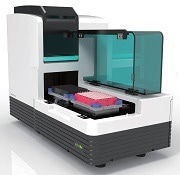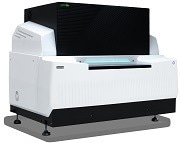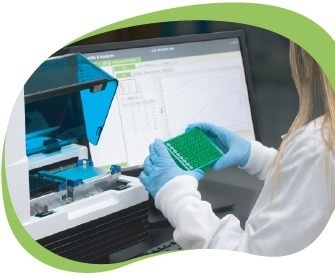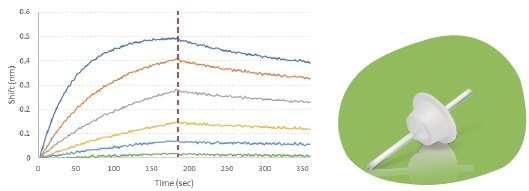The Gator® Plus is a medium-throughput device that can be used for quantitation, kinetics, and epitope binning. This equipment, based on biolayer interferometry (BLI) technology, offers quick results.
Achieve more “hands-off” time and rise above the noise.
This fluidics-free instrument can hold 96-well or 384-well microplates. Rich datasets can be acquired with little hands-on time, with a walk-away time of more than six hours. Gator® Plus is designed to analyze various biomolecules, including small molecules, antibodies, and proteins.
Gator® Plus facilitates improved baseline stability, producing high-quality data for precise analysis of the most complex pairs. Gator® Plus’s higher signal-to-noise ratio makes it simple to measure pM affinity pairs.
Specifications
Table 1. Source: Gator Bio, Inc.
| |
 |
 |
 |
| General Specifications |
Gator® Prime |
Gator® Plus |
Gator® Pro |
| Detection Technology |
Next-gen Biolayer Interferometry |
| Simultaneous Reads |
8 |
8 |
8, 16, 24, and 32 |
| Spectrometers |
8 |
8 |
32 |
| Acquisition Rate |
2, 5, and 10 Hz |
| Temperature Control |
Ambient plus 4 °C to 40 °C |
| Dimension (HxWxD) and Weight |
47 x 31 x 67 cm, 35 kg |
68 x 44 x 73 cm, 55 kg |
84 x 114 x 77 cm, 220 kg |
| Automation Compatible |
No |
No |
Yes |
| Performance Specifications |
Gator® Prime |
Gator® Plus |
Gator® Pro |
| Sample Types |
Proteins, antibodies, peptides, nucleic acids, liposomes, viruses, small molecules |
| Maximum Sample Capacity |
168 |
456 |
1152 |
| Types of Analysis |
Yes/no binding, quantitation, kinetics, affinity, off-rate ranking, epitope binning |
| Minimum Sample Volume |
100 μL |
40 μL |
40 μL |
| Baseline Noise (RMS) |
≤ 4 pm |
| Baseline Drift |
≤ 0.12 nm/hour |
≤ 0.1 nm/hour |
≤ 0.1 nm/hour |
| Associate Rate kon |
101 to 107 M-1 s-1 |
| Dissociation Rate koff |
10-6 to 10-1 s-1 |
| Affinity Constant KD |
10 pM to 1 mM |
| Binning Capacity |
12x12 |
16x16 |
32x32 |

Gator® Label-Free Analysis Systems. Image Credit: Gator Bio, Inc.
Biolayer interferometry (BLI)
Gator® systems are label-free analysis tools that use next-generation biolayer interferometry (BLI) technology. Biosensing probes are immersed in samples to identify biomolecular interactions.
Gator® probes are micro glass rods with specialized optical layers and surface chemistries coated on the distal ends.
The association or disassociation of biomolecules causes a phase shift in the optical interference pattern produced by the sensing surface of a probe. Continuous phase-shift measurements yield binding curves.

The sensorgram shows the real-time association and disassociation curves for a binding kinetics experiment using a Gator® system. Image Credit: Gator Bio, Inc.
Gator® systems’ simplicity, versatility, flexibility, and throughput have facilitated numerous therapeutic development, manufacturing, and life science research applications.
A powerful tool for discovery, development, and manufacturing
The next-generation BLI is more sensitive and has a more robust performance than other commercial BLI products. It also supports various applications, from drug discovery to therapeutic manufacturing.
Biotherapeutics
- Kinetics analysis
- Antibody titer measurements
- Epitope binning
- Manufacturing QC
- Process development
- Pharmacokinetics
Gene therapy
- Receptor interaction
- AAV quantitation and kinetics
- Neutralizing/total antibody detection
- Gene expression
Drug discovery and development
- Protein–small molecule interaction
- Peptide binding analysis
Life science research
- Receptor–ligand binding
- Protein-protein interaction
- Assay development and optimization
A user-friendly label-free technology
Gator® Systems are made up of instruments, probes, and a software package for data acquisition and analysis.
- Simple and fast assay setup
- Kinetics and affinity analysis
- Automated quantitation
- Quantitation, kinetics, and regeneration in one run
- Assay template generation
- Real-time binding curves
- Epitope binning
- Report generation
Gator® software for GMP and GLP
Users in GMP or GLP environments can use Gator® Part11 Software to abide by FDA 21 CFR Part 11 regulations. The Part11 Software collects data that is time-stamped and traceable. Account management, improved audit trails, and documented user sessions are all in accordance with FDA guidelines.
A full suite of applications
Table 2. Source: Gator Bio, Inc.
| Gator® Probe |
Function |
Application |
Dynamic Range |
Regeneration |
| ProA |
IgG titer |
Q |
0.02 – 2000 μg/mL |
Yes |
| ProG |
IgG titer |
Q |
0.02 – 2000 μg/mL |
Yes |
| ProL |
Kappa light chain titer |
Q |
0.02 – 2000 μg/mL |
Yes |
| SA |
Biotinylated and Avi-tagged molecules |
K/EP |
Protein dependent |
No |
| SA XT |
Biotinylated proteins and large molecules |
K |
Protein dependent |
No |
| Flex SA Kit |
Reusable SA kit |
K |
Protein dependent |
Yes |
| SMAP |
Measurement of small molecules, peptides (<150 Da) |
K |
Protein dependent |
No |
| HFC |
Human IgG characterization |
Q/K/QKR/EP |
0.05 – 300 μg/mL |
Yes |
| HFCII |
Advanced human IgG characterization |
Q/K/QKR/EP |
0.3 – 6000 μg/mL |
Yes |
| MFC |
Mouse IgG characterization |
Q/K/QKR/EP |
0.02 – 2000 μg/mL |
Yes |
| Anti–FAB |
F(ab), F(ab’)2 |
Q/K/QKR/EP |
0.3 – 3000 μg/mL |
Yes |
| APS |
Direct adsorption |
K |
Protein dependent |
No |
| AR |
Amine coupling immobilization |
K/EP |
Protein dependent |
No |
| His |
His-tagged proteins |
Q/K/QKR/EP |
Protein dependent |
Yes |
| Ni-NTA Kit |
His-tagged proteins through Ni-NTA |
Q/K/QKR/EP |
0.25 – 1000 μg/mL |
Yes |
| AAVX |
Direct binding titer (AAV1-10) |
Q/K |
1x109 – 1x1013 vp/mL |
Yes |
| AAV9 |
Direct binding titer (AAV9) |
Q/K |
3x109 – 1x1013 vp/mL |
Yes |
| HS AAV Kit |
High sensitivity titer (AAV1-8, 10) |
Q |
1x107- 5x1010 vp/mL |
No |
| HS AAV9 Kit |
High sensitivity titer (AAV9) |
Q |
1x107 - 1x109 vp/mL |
No |
| AAV Ratio Kit |
Empty vs Full Ratio Determination |
Ratio |
0-100% full |
No |
| Anti-Rabbit |
Rabbit-IgG |
Q/K |
1 - 500 μg/mL |
Yes |
| Anti-FLAG |
FLAG-tagged proteins |
K |
Protein dependent |
No |
| SARS-RBD |
RBD antibodies and receptors |
Q |
Protein dependent |
Yes |